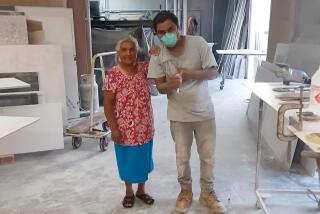Romancing the Stone, Wooing the Client: Cutters Try New Facet : Design: Their ancient art of crafting opulent furnishings has attracted high-profile customers. But their role has been low profile, so far.
- Share via
It’s against the rules for Jeff Dreisin and Bob Mira to say too much about their clients, so they don’t. This suits the clients and frustrates the partners, who have come to realize that secrecy inhibits growth.
“Nobody knows that we exist,” said Dreisin, Mira’s partner in Renaissance Stoneworks Inc. “That is a problem for us. You want everybody to know what you’re doing, but you have to keep a low profile.”
Buyers of their work tend to be wealthy on a scale that is hard to comprehend. But for all their flash and glitter, potentates and movie stars are private about what goes into their homes. This lets their agents and brokers keep Dreisin and Mira in the dark about where their work is headed.
“They have always tried to keep us as a deep secret while they’re making all the money on our work,” Dreisin said. “We finally got fed up and are trying to break out of that, and we’re starting to get results.”
For the first time in its 11-year existence, the Albertson, N.Y., company is trying to reach buyers directly. “It’s all the difference in the world,” Dreisin said. “Instead of getting paid $10,000 for something, now you’re getting $50,000 for exactly the same work. Now it’s fun.”
Renaissance Stoneworks makes extraordinary and expensive pieces out of semiprecious stone, especially the lush dark green malachite and the azure blue lapis lazuli. Operating in a dusty shop not open to the public, Dreisin, Mira and employees Jason Apostoleris and Tim Weaver slice the stone into thin strips and apply it veneer-style to turn countertops, tables and desks into showpieces.
These items are not to everyone’s taste or wallet. Most of them end up in the Mideast, where the use of malachite and lapis goes back to antiquity. Their most expensive piece to date was a malachite-covered entertainment center that they sold for $350,000.
“Even your average millionaire is not willing to spend $100,000 on a countertop,” Dreisin said. “It’s really for your decadently wealthy clientele who want something that no one else is going to have.”
The entertainment center reposes in a Middle Eastern palace they won’t identify further. They know the identity of the buyer in this case only because Mira was summoned on a moment’s notice to repair another of their works, a malachite tabletop broken in transit.
“It was a rare opportunity to see my work in place,” said Mira, who had never imagined such opulence. “The sheer magnitude and size and wealth--it’s just beyond words. I could have put my entire house in just one room of this palace.”
Mira, 38, and Dreisin, 40, have worked together for almost 20 years. Dreisin had been part-owner of a delivery service, where folks who could afford it paid to have their whatnots delivered. “I really hated it,” he said.
A friend introduced him to a former Big Band musician who crafted jewelry in his basement. “It sounded interesting,” said Dreisin, who visited, stayed and learned.
Dreisin brought in Mira, who was then a chemical salesman. After eight years, the two struck out on their own to start Renaissance Stoneworks. “We had $200 in the bank and three jobs, small stuff,” Dreisin said.
As in the previous shop, they turned semiprecious stones into cuff links and little boxes and picture frames. “The more we worked in that vein, the more we were made aware of what used to be done in the old days, and that made us hungry to go into that same vein,” Mira said of the glory days of lapidary, stone-cutting’s formal name. “We didn’t stay with the jewelry and the little boxes, because everybody does that. We wanted to do something different. We wanted to make a statement.”
“Something that someone else does,” Dreisin said, “we don’t want to do it anymore.”
Customers cooperated by asking for more elaborate works, which now are limited, as Dreisin said, “only by our imagination and your budget.” Among their major works were the Jacuzzi on a billionaire’s airplane and all the countertops in a Washington apartment, just one of which cost $100,000 (done in lapis for a guest bathroom). On their design table is a 15-foot-high malachite-and-gold fountain for a palace.
“We wanted to be true artists in this type of work,” Mira said. “Back in the Medici days in Italy, they used to commission small workshops like our own to make works of art that are still around today. We have always envisioned that our work will far exceed our lives.”
Renaissance Stoneworks uses two or three tons of malachite a year. It comes from Zaire in boulders, grapefruit-sized to 150-pounders. The more expensive lapis, of which they use about 200 pounds a year, comes from Afghanistan.
“You meet some real adventurers,” Dreisin said of the traders who bring the rock out of dangerous places. “These guys are out of the movies.”
The Renaissance stonecutters use water-cooled, diamond-tipped blades ranging up to 36 inches across to slice the rock into strips several inches long and about one-eighth of an inch thick. These are epoxied to marble and ground and polished to a smooth and lustrous veneer.
Clients often like their malachite to include a design, which the stonecutters produce by combining nuances in shading and pattern. “No two jobs are ever the same,” Dreisin said.
The hard part is shaping the stone into curves. “That’s a trade secret,” Dreisin said. “It’s not any one trick. It’s 20 tricks. And the end result appears as though it’s carved out of a solid piece. There’s only a handful of people in the world that know how it’s done.”
Those who know how to find Renaissance Stonecutters include designers and galleries that order work on someone else’s behalf--and get their own cut of the action.
To increase their revenue, which approached $1 million last year, Dreisin and Mira want to bypass some of those in the middle. To do this, they recently were the subject of a show in Saudi Arabia and are about to open a showroom in Beirut.
“Things have been tight for the last 10 years, very tight,” Mira said. “But now that we’ve made our new contacts, now that we’re doing pieces of the size that we’re doing . . . it’s starting to roll in.”
“That’s my goal,” Dreisin said, “to be able to afford my own stuff.”
More to Read
Inside the business of entertainment
The Wide Shot brings you news, analysis and insights on everything from streaming wars to production — and what it all means for the future.
You may occasionally receive promotional content from the Los Angeles Times.










